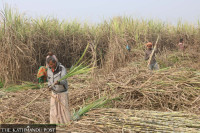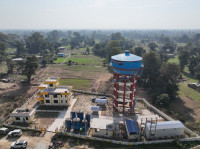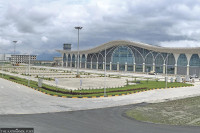Money
New trade strategy lists 32 promising exports
The plan has been designed to support Nepal’s graduation from least developed country status to developing country by 2026, officials say.
Krishana Prasain
Nepal has rolled out the Nepal Trade Integrated Strategy (NTIS) 2023 by greatly expanding the list of promising export products and services from 12 to 32.
NTIS 2023, which supersedes NTIS 2016, was implemented on July 17. The latest trade strategy has been designed to support Nepal's graduation from least developed country (LDC) status to developing country by 2026, officials said.
“Our aim is to diversify the export market and for this, a country-wise strategy will be prepared and implemented,” said Govinda Karki, joint secretary at the Industry Ministry.
The new products in NTIS 2023 are lentils, jute, vegetables, fruits, spices and coffee in the agro category; and handmade lokta paper, rosin and turpentine, fragrant oil and textiles of long fibre in the forest sector category.
Iron and steel, cement and readymade garments have been added in the large-scale industry category.
Jewellery, pasta, Himalayan spring water, honey, dog chew and felt have been inserted in the small and cottage industries category.
Electricity has been added in the service export category.
NTIS 2016 contained cardamom, ginger, tea and medicinal and aromatic plants in the agro-based products category; and fabrics, textiles, yarn and rope; leather, footwear, pashmina and carpets in the craft and manufacturing category.
There are three items in the services category: One, skilled and semi-skilled professionals in remittance-generating services; two, IT and business process outsourcing (BPO) and IT engineering; and three, tourism which includes leisure, business, education and medical.
Nepal developed and adopted NTIS 2010 as an updated version of the Nepal Trade and Competitiveness Study 2004 that focused on the development of 12 goods and seven services to contribute to the poverty reduction goal adopted by the government by making trade inclusive and equitable.
The strategy was revised in 2016. The list of products and services identified for special treatment was whittled down to 12 from 19 in 2016. Items on the list get special privileges for export.
“The export items have been selected on the basis of demand in a particular country. We will sign agreements with new countries to facilitate exports in the context of graduating Nepal. We will review the trade agreements too,” Karki said.
Export earnings from goods identified by NTIS 2016 swelled to Rs48.11 billion in fiscal 2022-23 from Rs38.41 billion in the previous fiscal 2021-22, according to the Department of Customs.
Apart from the listed goods, exports of other goods amounted to nearly Rs37 billion in the last fiscal year.
Nepal exported vegetables worth Rs2.90 billion; coffee, tea, maté, and spices worth Rs17.07 billion; Portland cement worth Rs358.95 million; drinking water worth Rs543.95 million; pasta worth Rs2.29 billion; iron and steel worth Rs10 billion; and dog chew worth Rs3.40 billion.
Nepal will be stepping into uncharted territory after it is inducted into the company of middle-income developing countries in 2026, and exporters are beginning to worry about the higher tariffs and stricter rules of origin provisions that are sure to follow.
As an LDC, Nepal has been receiving preferential treatment from its trading partners, but after 2026, it will have to hold its own.
In November 2021, the United Nations General Assembly approved a proposal to upgrade Nepal from an underdeveloped country to a middle-income developing country by 2026.
But the country will not be left to fend for itself right away. It has been given a five-year preparatory period to allow a smooth transition, considering Covid-19 and the need to implement policies and strategies to reverse its damage to the economic and social sectors.
Nepal was included on the LDC list in 1971.
Graduation will mean losing a host of international support measures offered by the international community to aid Nepal’s efforts in overcoming its development-related challenges.
A major implication of LDC graduation is the loss of preferential market access available through LDC-specific schemes under the Generalised System of Preferences (GSP) and other arrangements.
“We are confident that the changes made in the NTIS list will help boost exports. Nepal is under pressure to increase exports to earn and become self-reliant,” said Karki.
According to the new NTIS, an estimated Rs463 billion will be required for its implementation.
The major target of NTIS 2023 is to attain Nepal’s trade-to-GDP ratio of 55 percent by 2026 from 43.81 percent in 2021. Trade is the sum of exports and imports of goods and services measured as a share of the gross domestic product.
The new NTIS has targeted goods and services exports to represent 20 percent of Nepal’s GDP, from 6.3 percent in the base year 2021-22.
"The government has allocated a budget of Rs40 million this fiscal year to implement the new NTIS," said Karki.
According to the new NTIS, the United States, the European Union, the United Kingdom and Turkey are the major export markets for Nepali goods besides India; and it is important to conduct a study of the subsidies used by Nepal in these countries and their impact after graduation.
“A steering committee has been formed which compromises representatives from different government bodies to work on implementing the new NTIS,” said Karki. "The National Programme Implementation Unit has been formed for day-to-day follow-up," he said.
Nepal has lacked proper coordination for a long time to implement the NTIS, experts said. Product development and quality enhancement are not limited to the Industry Ministry. Other ministries like Finance, Agriculture, Forest and Physical Infrastructure, among others, need to work together, they said.
“Lack of coordination among the government agencies concerned has been one of the major issues since the NTIS was initiated. There is a question mark about how the agencies will work together,” said Paras Kharel, executive director of South Asia Watch on Trade, Economics and Environment.
"Going by past experience, the progress of the NTIS has not been encouraging," Kharel said.
"For instance, the Board of Trade is required to hold a certain number of meetings in a year as per the commerce policy, but it has not done so for many years. So, the implementation of the NTIS is still doubtful,” he said.
"Reviews of NTIS 2010 and NTIS 2016 have highlighted lack of coordination among the concerned government bodies," he said.
According to experts, frequent changes in bureaucrats, ministers, policies and government have also hindered the smooth implementation of the NTIS. There are other issues like lab resources and technical human resources.
The NTIS is reviewed every five years, but due to changes in government, the last review was done after seven years.




 14.12°C Kathmandu
14.12°C Kathmandu













